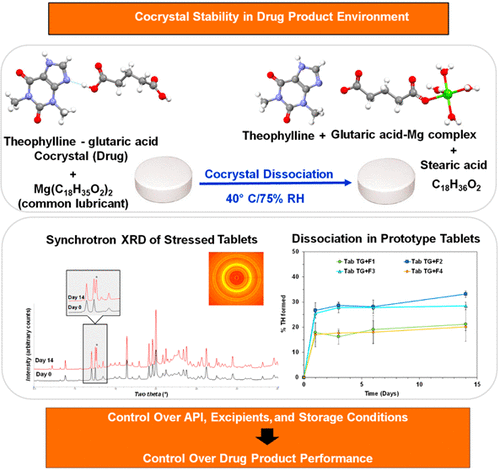当前位置:
X-MOL 学术
›
Mol. Pharmaceutics
›
论文详情
Our official English website, www.x-mol.net, welcomes your
feedback! (Note: you will need to create a separate account there.)
Challenges in Transitioning Cocrystals from Bench to Bedside: Dissociation in Prototype Drug Product Environment
Molecular Pharmaceutics ( IF 4.5 ) Pub Date : 2018-06-27 00:00:00 , DOI: 10.1021/acs.molpharmaceut.8b00340 Sampada Koranne 1 , Anasuya Sahoo 1 , Joseph F. Krzyzaniak 2 , Suman Luthra 2 , Kapildev K. Arora 2 , Raj Suryanarayanan 1
Molecular Pharmaceutics ( IF 4.5 ) Pub Date : 2018-06-27 00:00:00 , DOI: 10.1021/acs.molpharmaceut.8b00340 Sampada Koranne 1 , Anasuya Sahoo 1 , Joseph F. Krzyzaniak 2 , Suman Luthra 2 , Kapildev K. Arora 2 , Raj Suryanarayanan 1
Affiliation

|
Tablets containing a theophylline–glutaric acid (TG) cocrystal dissociated rapidly forming crystalline theophylline (20–30%), following storage at 40 °C/75% RH for 2 weeks. Control tablets of TG cocrystal containing no excipients were stable under the same conditions. The dissociation reaction was water-mediated, and the theophylline concentration (the dissociation product), monitored by synchrotron X-ray diffractometry, was strongly influenced by the formulation composition. Investigation of the binary compacts of the TG cocrystal with each excipient revealed the influence of excipient properties (hydrophilicity, ionizability) on cocrystal stability, providing mechanistic insights into a dissociation reaction. Ionizable excipients with a strong tendency to sorb water, for example, sodium starch glycolate and croscarmellose sodium, caused pronounced dissociation. Microcrystalline cellulose (MCC), while a neutral but hydrophilic excipient, also enabled solution-mediated cocrystal dissociation in intact tablets. Magnesium stearate, an ionizable but hydrophobic excipient, interacted with the cocrystal to form a hygroscopic product. The interaction is believed to be initiated in the disordered cocrystal–excipient particle interface. In contrast, the cocrystal was stable in the presence of lactose, a neutral excipient with no tendency to sorb water. The risk of unintended cocrystal dissociation can be mitigated by avoiding contact with water both during processing and storage.
中文翻译:

共晶从工作台过渡到床边的挑战:原型药物产品环境中的离解
在40°C / 75%RH下保存2周后,含有茶碱-戊二酸(TG)共晶的片剂迅速分解形成结晶茶碱(20-30%)。不含赋形剂的TG共晶体的对照片剂在相同条件下是稳定的。离解反应是水介导的,并且通过同步加速器X射线衍射法监测的茶碱浓度(离解产物)受制剂组成的强烈影响。对TG与每种赋形剂的二元压块的研究表明,赋形剂性质(亲水性,可电离性)对共晶稳定性的影响,为解离反应提供了机械原理。具有较强吸水趋势的可离子化赋形剂,例如羟乙酸淀粉钠和交联羧甲基纤维素钠,引起明显的解离。微晶纤维素(MCC)虽然是一种中性但亲水的赋形剂,但也可以在完整的片剂中进行溶液介导的共晶解离。硬脂酸镁是一种可电离但疏水的赋形剂,它与共晶体相互作用形成吸湿性产品。据信这种相互作用是在无序共晶体-赋形剂颗粒界面中引发的。相反,共结晶在乳糖的存在下是稳定的,乳糖是一种中性赋形剂,没有吸附水的趋势。通过避免在加工和储存过程中与水接触,可以降低意外共晶离解的风险。可电离但疏水的赋形剂,与共晶体相互作用形成吸湿性产品。据信这种相互作用是在无序共晶体-赋形剂颗粒界面中引发的。相反,共结晶在乳糖的存在下是稳定的,乳糖是一种中性赋形剂,没有吸附水的趋势。通过避免在加工和储存过程中与水接触,可以降低意外共晶离解的风险。可电离但疏水的赋形剂,与共晶体相互作用形成吸湿性产品。据信这种相互作用是在无序共晶体-赋形剂颗粒界面中引发的。相反,共结晶在乳糖的存在下是稳定的,乳糖是一种中性赋形剂,没有吸收水的趋势。通过避免在加工和储存过程中与水接触,可以降低意外共晶离解的风险。
更新日期:2018-06-27
中文翻译:

共晶从工作台过渡到床边的挑战:原型药物产品环境中的离解
在40°C / 75%RH下保存2周后,含有茶碱-戊二酸(TG)共晶的片剂迅速分解形成结晶茶碱(20-30%)。不含赋形剂的TG共晶体的对照片剂在相同条件下是稳定的。离解反应是水介导的,并且通过同步加速器X射线衍射法监测的茶碱浓度(离解产物)受制剂组成的强烈影响。对TG与每种赋形剂的二元压块的研究表明,赋形剂性质(亲水性,可电离性)对共晶稳定性的影响,为解离反应提供了机械原理。具有较强吸水趋势的可离子化赋形剂,例如羟乙酸淀粉钠和交联羧甲基纤维素钠,引起明显的解离。微晶纤维素(MCC)虽然是一种中性但亲水的赋形剂,但也可以在完整的片剂中进行溶液介导的共晶解离。硬脂酸镁是一种可电离但疏水的赋形剂,它与共晶体相互作用形成吸湿性产品。据信这种相互作用是在无序共晶体-赋形剂颗粒界面中引发的。相反,共结晶在乳糖的存在下是稳定的,乳糖是一种中性赋形剂,没有吸附水的趋势。通过避免在加工和储存过程中与水接触,可以降低意外共晶离解的风险。可电离但疏水的赋形剂,与共晶体相互作用形成吸湿性产品。据信这种相互作用是在无序共晶体-赋形剂颗粒界面中引发的。相反,共结晶在乳糖的存在下是稳定的,乳糖是一种中性赋形剂,没有吸附水的趋势。通过避免在加工和储存过程中与水接触,可以降低意外共晶离解的风险。可电离但疏水的赋形剂,与共晶体相互作用形成吸湿性产品。据信这种相互作用是在无序共晶体-赋形剂颗粒界面中引发的。相反,共结晶在乳糖的存在下是稳定的,乳糖是一种中性赋形剂,没有吸收水的趋势。通过避免在加工和储存过程中与水接触,可以降低意外共晶离解的风险。











































 京公网安备 11010802027423号
京公网安备 11010802027423号